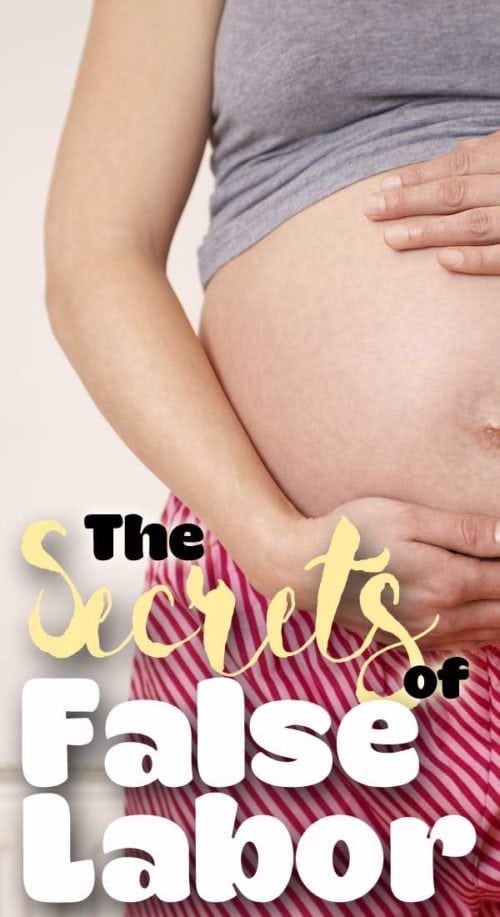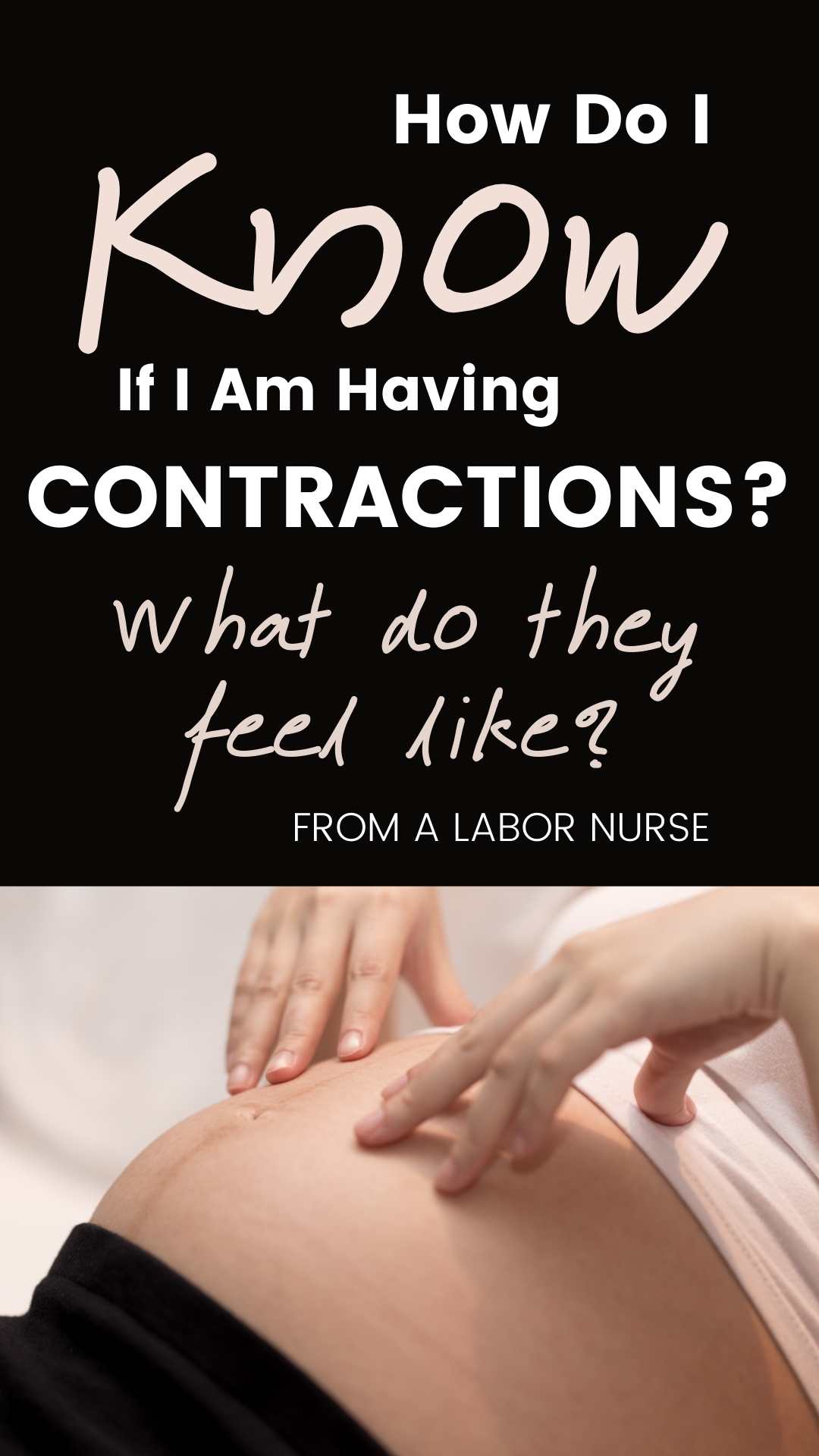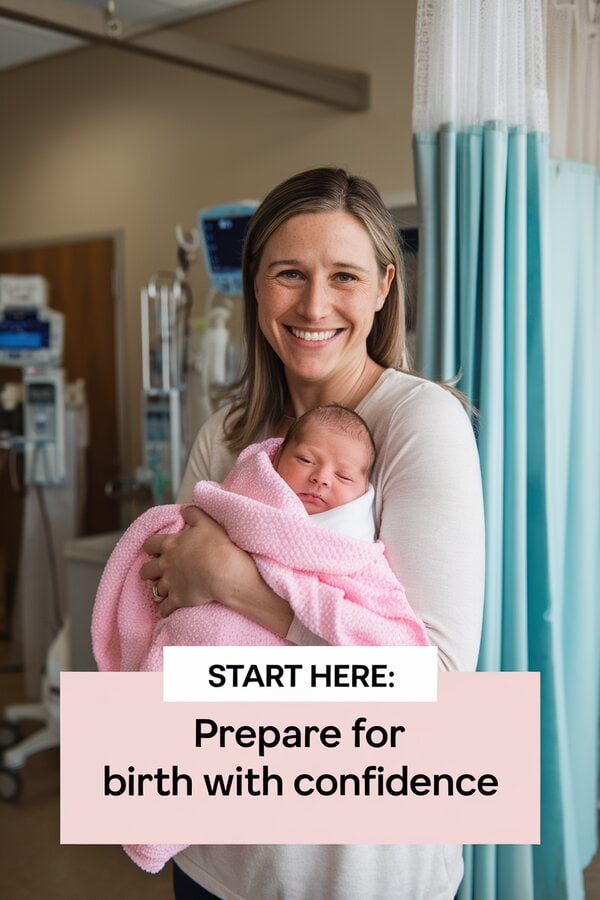What does a contraction feel like? We’ll talk about what watch for in labor pains. How to know if they are just Braxton Hicks, and how to time them.

Ok, so why do I know about contractions?
Hi, I’m Hilary — many people know me as The Pregnancy Nurse® 👩⚕️. I have been a nurse since 1997 and I have 20 years of OB nursing experience, I am also the curly head behind this website Pulling Curls and The Online Prenatal Class for Couples. 🩺 I have literally helped THOUSANDS of couples learn what contractions feel like (and I’ve seen even more in labor). I am a trusted resources as you’re figuring out what to expect from your body.
Of course, this is NOT MEDICAL ADVICE and we recommend you talk to your provider about all of the pains you are having. But, ESPECIALLY before you are 36 weeks your provider would prefer that you aren’t having many contractions in an hour. Please be sure to contact them if you’re having more than 5 uterine contractions in an hour and are less than 36 weeks (or whatever the # is that they have told you).
Before we get going — have you made a birth plan? Let me help you out here:
What does a contraction feel like?
I spent MUCH of my first pregnancy wondering WHAT the big day would feel like? What would contractions feel like? What would labor feel like? All of those are very normal first-time mom questions!
What is a contraction?
A contraction is your uterus (which is basically, just a large muscle) tightening down on the baby. I really like how this video shows it:

I like to think of your cerivx as a tight sweater neck. Where the uterus is just slowly pushing the baby’s head through it. So, it starts really small and grows as the head pushes on it more and more (I explain a bit more about that in my vaginal exams post)
All of that is thanks to contractions.
There are different types of contractions. Some are meant to soften your cervix to get it ready to have the baby go through it, and some start at the top of your uterus and really PUSH that baby down. All of them are important, but some don’t really lead you into having the baby within the next day.
While you might call that a “false alarm” — but it’s important to remember that ALL these pains have their own place in this process.
When you hit ten centimeters (check out this post to learn more about vaginal exams), you’ll push in time with your contractions to give that baby it’s final shove out your vagina.
It’s all really a miracle. Just sort of a painful one. 🙂
Want more info on contractions, check out these posts:
- Contractions vs Braxton Hicks Quiz
- What Toco Reading is a Contraction?
- True Labor Contractions: The signs of real labor
- What To Do When You’re Having Contractions
- Where Do You Feel Contractions?
I’ll be the first to say that all of this sounds kind of scary and alien-esque if I think about it too much without the proper support.
Pro Tip if that’s you: Come join me The Online Prenatal Class for Couples — it is your ONE STOP SHOP for birth prep:
What will I feel?
For me, contractions felt like a bad stomach ache or cramps with your period. You have to realize that you might just feel “crappy” much of the day — similar to how you feel during a bad period. That can be contractions (or, you just feel crappy).
Sidenote: if your stomach is gurgling during pregnancy << I have a post on that too.
Period cramps ARE contractions — they’re your uterus wringing out what was left of the lining that it built up since it’s not pregnant.
Often they start out as just “tight” or some mild discomfort, and continue to be more painful from there.
Contractions are “wave-like” (like the tidal waves of the ocean) in that they come in, and go away, and come back, and go away….
Most pregnant women describe them this way:
- Dull pelvic pain that comes and goes
- Menstrual Cramps or period pains
- Stomach cramps (but a bit lower than you’d feel them with actual stomach cramps)
- They intensify (get more painful)
Please note that contractions tend to come and go, meaning a constant dull ache in your pelvis is not too likely to be labor (unless also accompanied by other pains).
I have a whole post just on true labor contractions and how to differentiate them between false labor.
Of course, you likely haven’t had a period in quite a while. So, while that is a bummer — just try to remember back….
For a lot of women, that can be somewhat confusing (don’t miss my post all about the signs of labor)
SO, I have a solution… The Online Prenatal Class for Couples talks about it in depth — a snippet of it can be watched below:
Where do you feel your contractions?
Because your uterus is a pretty big muscle — you can feel your contractions in a variety of places. Areas women often feel them include:
- Lower abdomen
- Back (both lower and a bit higher)
- Hips
Pro Tip: It is really hard to pinpoint the start of labor. You can look back afterwards and realize when things got more serious, but the start of labor is pretty nebulous.
The weirdness of all of it is why it’s probably great to get a few things in your hospital bag soon:
Contractions feel like the baby moving?
I get this question a lot. Large amounts of fetal movement can trigger a contraction — so sometimes those happen together.
Contractions CAN feel like the baby is moving — they cause similar pangs and pains. A lot of my patients, once I have them on the monitor — and tell them it’s a contraction, will say — “Oh, I just thought the baby was moving.” So, that’s not unusual.
Looking for more info on baby moving? — be sure to check out these posts:
- It Feels Like My Water is Going to Break When Baby Moves
- Normal Daily Fetal Movement – Kick Counts
- When to Go To The Hospital for Decreased Fetal Movement?
- Feel Baby Move in Lower Abdomen
- Fetal Movement & Kick Counts
How do I know I’m contracting?
Your uterus will start to feel hard under your skin when you contract. It can be hard to tell for sure — but if you lay down, and really try to relax, as well as pressing on your belly when you feel the contraction, as well as when you don’t — you might be able to feel it.
But, you’ll also know it from a lot of pain.
If you’re sure not sure I’d call your provider and talk it over with them.

Contractions on the monitor but I’m not feeling them
This actually isn’t unusual at all. Contractions come in all shapes and sizes. Sadly, you usually need to feel them in order for them to do any work for you, but a lot of women have no idea they’re contracting until I put them on the monitor.
I actually have a whole post on The Pregnancy Nurse on what to do in if contractions show but you don’t feel them, and a post on what the contraction monitor (called a toco) sees at the hospital. And yes, it does vary depending on how close you are to do your due date. If your belly is super small, they will likely show-up smaller.
Those monitors can feel REAL intimidating, which is why we go over what to expect from them a bunch in here.
What do Braxton Hicks Contractions Feel Like?
Here’s the crazy thing, Braxton Hicks contractions feel pretty similar. Yes, they are likely less intense or painful… but yeah. They all seem similar. So, that makes it hard.
The main difference for “real contractions” is that you eventually go into labor. But, the other contractions I felt in the weeks up to actually going into labor felt VERY similar to the early labor contractions that pushed us into the “real thing”

What The Signs of “Real Labor Contractions”
I think a table would be helpful for this one:
| “Real Contractions” | “False Labor Contractions” |
| Tend to come at regular intervals, and in a regular pattern. | Seem to be more random in how they come, much more irregular contractions |
| Labor tends to be felt throughout your torso | Often is just in your belly or back labor — isn’t all over. |
| Often are more painful and you may be seeing pain relief. | Tends to be easier to breathe through. |
| Have other signs with it like nausea or loss of the your mucus plug | May just be contractions on their own. |
| May also include some “bloody show” (a small amount of bleeding) or changes in discharge | No real changes in discharge. |
| Pushes Baby into the birth canal | No measurable progress of the baby into your pelvis |
Remember, that these “false labor contractions” really are your body’s way of softening your cervix and getting your body more ready for labor (so it’s easier to think of them as early contractions). Braxton Hicks contractions (often also called practice contractions) are just making VERY small changes to your body before baby heads into the birth canal with real contractions.
In fact, sometimes the latent stage of labor (also called early labor, or if it’s long prodromal labor) can really last quite a while and sort of “turn on and off” a few times before you get into the active stage of labor.
I have a whole post that explains the stages of labor (and goes into how long labor will last).
Pro Tip: If you’re feeling contractions frequently, it’s not a bad idea to time contractions. At least at that point you’ll know how frequent they are (and if they’re in a pattern or random). This is a great thing for your partner to do (and there’s lots of apps out there that can help them). And yes, we talk all about how to do that in here (I teach your partner too!).
Feeling like you have a LOT to learn about labor? Grab my free insider tips here:
How Do I Go Into Labor?
I have a few posts that share about how you might get contractions going if you’re feeling SOMETHING but really want to have your baby:
- Will a prenatal massage put you into labor?
- Will jumping jacks put your into labor?
- Will a warm bath put you into labor?
Other tips are to make sure that you frequently change positions (unless you’re asleep) so that baby can find their best way out.
Make sure you’re eating, to give your uterus muscles the energy they need to do their job.
Maybe you’ll agree with me in that what seems like it will “just happen” can feel really confusing at the end.
It helps SO much when you have an expert simplify it for you. The Online Prenatal Class for Couples is truly the EASY way to get prepared for your hospital birth. It takes just a few hours and you’ll be prepared before you know it (even on complicated things like this).
Or, if you’re not quite ready for the full class, check out my free insider tips — It’s your first step towards being your own birth boss.
I have a whole podcast on what a contraction feels like that you might enjoy”












DGS says
contraction is just like a heavy pain or something like this but knowing them before labor will help a woman to understand contraction. and how to manage them while birthing the child.